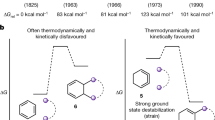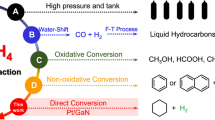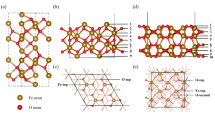Abstract
DURING the course of an investigation which is being made on the decomposition of amines in the presence of hydrogen over evaporated metal-film catalysts, an unexpected example of selective catalytic action has been observed. The decomposition of cyclohexylamine on evaporated platinum films at 134° C. was expected to produce cyclo-hexane and ammonia according to the equation  The reaction was followed by continuous massspectrometric analysis of the reacting gases by a technique described elsewhere1. As the ions of mass 99 (C6H11NH2
+) decreased in number, ions of mass 17 (NH3
+) appeared but very few ions of mass 84 (C6H12
+) were observed. A search throughout the mass-range covered by the spectrometer indicated that large quantities of ions of mass 78 were being produced, suggesting that the primary product of the reaction was benzene (C6H6) rather than cyclohexane. Now the position of the equilibrium2 in the reaction
The reaction was followed by continuous massspectrometric analysis of the reacting gases by a technique described elsewhere1. As the ions of mass 99 (C6H11NH2
+) decreased in number, ions of mass 17 (NH3
+) appeared but very few ions of mass 84 (C6H12
+) were observed. A search throughout the mass-range covered by the spectrometer indicated that large quantities of ions of mass 78 were being produced, suggesting that the primary product of the reaction was benzene (C6H6) rather than cyclohexane. Now the position of the equilibrium2 in the reaction  is well over on the side of cyclohexane under the conditions used in this work. The initial reaction mixture consisted of 1.8 mm. cyclohexylamine and 23 mm. hydrogen and, assuming complete conversion according to reaction (1) and the known equilibrium constant for reaction (2), the maximum pressure of benzene to be expected at 134° C. was only about 10−3 mm. The identification of the source of the mass 78 ions as benzene was therefore considered tentative until it was found that when most of the cyclo-hexylamine was used up the ions of mass 78 began to disappear again and in turn substantial quantities of ions of mass 84 were formed. This showed that the normal catalytic hydrogenation of benzene to cyclohexane, to be expected on a metal like platinum, was then taking place. The formation of benzene was also confirmed by stopping a typical reaction and identifying the benzene in the reaction mixture by vapour-phase chromatography. The whole course of the reaction is shown in Fig. 1.
is well over on the side of cyclohexane under the conditions used in this work. The initial reaction mixture consisted of 1.8 mm. cyclohexylamine and 23 mm. hydrogen and, assuming complete conversion according to reaction (1) and the known equilibrium constant for reaction (2), the maximum pressure of benzene to be expected at 134° C. was only about 10−3 mm. The identification of the source of the mass 78 ions as benzene was therefore considered tentative until it was found that when most of the cyclo-hexylamine was used up the ions of mass 78 began to disappear again and in turn substantial quantities of ions of mass 84 were formed. This showed that the normal catalytic hydrogenation of benzene to cyclohexane, to be expected on a metal like platinum, was then taking place. The formation of benzene was also confirmed by stopping a typical reaction and identifying the benzene in the reaction mixture by vapour-phase chromatography. The whole course of the reaction is shown in Fig. 1.
This is a preview of subscription content, access via your institution
Access options
Subscribe to this journal
Receive 51 print issues and online access
$199.00 per year
only $3.90 per issue
Buy this article
- Purchase on SpringerLink
- Instant access to full article PDF
Prices may be subject to local taxes which are calculated during checkout
Similar content being viewed by others
References
Kemball, C., Proc. Roy. Soc., A, 207, 539 (1951).
Janz, G. J., J. Chem. Phys., 22, 751 (1954).
Author information
Authors and Affiliations
Rights and permissions
About this article
Cite this article
MOSS, R., KEMBALL, C. An Unexpected Catalytic Dehydrogenation. Nature 178, 1069 (1956). https://doi.org/10.1038/1781069a0
Issue date:
DOI: https://doi.org/10.1038/1781069a0



